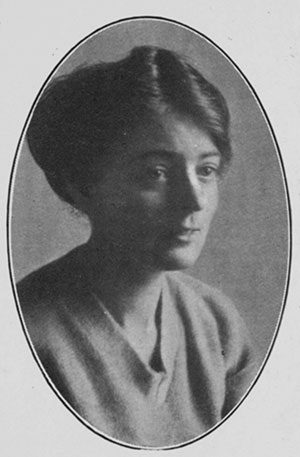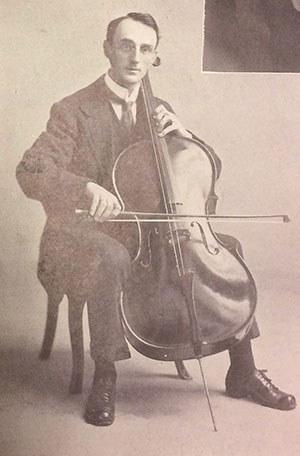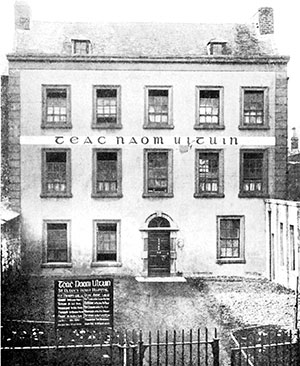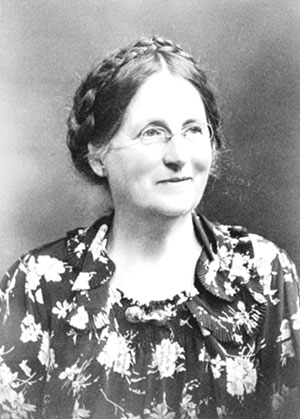REPUTATIONS: ‘Friend of the poor’: Dora Maguire
Published in 20th Century Social Perspectives, Features, Issue 6 (November/December 2018), Volume 26In R.M. Fox’s collection of biographical essays Rebel Irishwomen (1935), included alongside Maud Gonne MacBride, Hanna Sheehy-Skeffington and Constance Markievicz is an obscure London-born nurse, Dora Maguire. Who was she and what did she achieve during her short life?
By James Curry
An unlikely Irish republican and labour activist, Theodora Agnes Eleanor Maguire was born on 7 September 1889 at her family home of 12 Earl’s Court Square, Kensington, London. Known as Dora to friends and family, she was one of at least six children born to ‘Unionist, Protestant, but not Orange’ barrister-at-law Thomas Miller Maguire and his wife Eleanor Eliza (née Wragge). According to a census return given three decades after his marriage, Dora’s father originally hailed from Bray, Co. Wicklow, although Fox claimed that ‘the family was centred in Enniskillen’, Co. Fermanagh. In her youth, Dora attended an aunt’s boarding school in Belfast, developing an Irish accent that seemingly stayed with her for life and rebelling against the ‘naked, unjust anti-Irish and anti-Catholic attitude’ around her by evolving into an ‘ardent Republican’.

Above: Dora Maguire as she appeared in both editions of R.M. Fox’s Rebel Irishwomen. (NLI).
‘Nurse Maguire’
At the age of seventeen, she ‘went off as a probationer to a Fever Hospital’, and four years later was recorded in the census as a ‘hospital nurse’ in the Berkshire civil parish of St Helen Without. During the Great War, she was employed at Blackburn Infirmary and developed suppressed diphtheria. Upon returning to London as an extern nurse at a tubercular clinic, her health continued to deteriorate. She became infected with tuberculosis and was often forced to sit on doorsteps to recover from regular fainting episodes. In the evenings she nursed her father, who, after a long and painful illness, passed away in September 1920.
Thereafter Dora followed her elder sister, Mary, to Dublin, ‘apparently to die’, Fox wrote, ‘for she could hardly walk’ at the time. A mezzo-soprano married to respected cellist Joseph Schofield, Mary Maguire carved out a reputation ‘as a singer who frequently delighted Irish broadcasting audiences’. Politically, she had been the first within her family to break openly with tradition, after getting ‘caught by the national enthusiasm’ for Irish independence following the 1916 Easter Rising. She later performed alongside her Leeds-born husband when ‘singing at national gatherings which had to be carefully concealed from the Black and Tans’.

Above: Joseph Schofield (1886–1939), a respected cellist who married Dora’s elder sister Mary, a mezzo-soprano singer. She had been the first within her family to break openly with tradition, after getting ‘caught by the national enthusiasm’ for Irish independence following the 1916 Easter Rising. (Royal Irish Academy of Music).
After her health improved in Ireland, Dora converted to Catholicism and ‘threw herself into all the advanced Dublin movements’. In the early 1920s she took up a post as ‘nurse-secretary’ at Teach Ultáin (St Ultan’s) at 37 Charlemont Street in Ranelagh, a small yet dynamic hospital for Irish infants suffering from non-infectious diseases. Co-founded in 1919 by Dr Kathleen Lynn and Madeline ffrench-Mullen, at a time when Dublin infants had more than a 16% chance of passing away before their first birthday, the institution was almost entirely staffed by women. During her four years of employment there, Dora attended Lynn’s dispensaries and was charged with the task of ‘giving tuberculin and vaccine to the poorer patients’.
The Princess Cinema and the prince of Wales
While other republican women in Dublin were discussing potential demonstrations against the screening in the city of short films about the prince of Wales’s recent tour of South Africa, Dora quietly entered the Princess Cinema in Rathmines on 6 August 1925 with a large inkpot hidden on her person. Much to ‘the annoyance of the management and audience’ and the amusement of republicans across Ireland, she stood up and hurled her makeshift missile over the heads of the theatre orchestra as soon as the offending picture was shown, causing an estimated £6-10s’ worth of damage to the screen.

St Ultan’s children’s hospital, 37 Charlemont Street, Ranelagh, where Dora Maguire worked for four years in the 1920s as a ‘nurse-secretary’. (Royal College of Physicians of Ireland).
During her trial Dora refused to recognise the authority of the district court judge, and she responded to the testimony of musicians whose clothes and belongings had also been damaged with the statement that ‘if the ladies would call to her house she would compensate them, but not by order of the court’. It was revealed that on her way to Rathmines station Dora had informed the constable who arrested her that ‘she had no personal objection to the Prince of Wales, but she objected to the cheering for those who helped the Black and Tans’. As well as claiming that a second policeman present had secretly supported her act and remarked that his wife viewed the Union Jack as a ‘rotten rag’, Dora provoked laughter in the court by stating that the cinema’s manager had openly despaired that she chose to target his establishment rather than the nearby Stella Theatre or another Dublin picture-house.
Refusing to apply for bail, she was fined £2 for conduct likely to provoke a breach of the peace, ordered to pay £5 compensation to the cinema and returned for trial to the next circuit court. Although not listed as a permanent lodger, at the time of her publicised arrest in 1925 Dora was revealed to be living at Kathleen Lynn’s private practice and residence in 9 Belgrave Road, Rathmines. On the night of her arrest, after rushing to Rathmines station with a rug and tea upon hearing the news, Lynn and another friend had found the prisoner ‘quite cheerful’ in her cell.
Desolate Derry
Having subsequently applied for a nursing position in her father’s home town of Bray ‘only to meet with the “oath” barrier’, Dora relocated to Derry, where, without having to pledge her allegiance to the British monarch, ‘she was able to work as a district nurse’. Although she later ‘spoke affectionately of the twinkling lights on the hillsides of Derry’ and had friends there who admired her courage and urged her to take part in amateur theatricals, Dora was stationed in a ‘desolate region … [and] forced to live at a small country inn, a centre of Orangism in the district and the meeting place for the B Specials of Ulster’. Undaunted, she ‘speedily dumped the pictures of British royalty out of the room’ and proceeded to play The Soldier’s Song on her fiddle. She also turned down the offer of an escort from the city on 12 July, recognising that ‘her own courage was her best protection’. Dora soon suffered another breakdown in health and was forced to spend several months living at a ‘bleak sanatorium’ in Rostrevor, Co. Down, which specialised in tuberculosis care.
After returning to Dublin, she ‘was soon busy posting up placards and chalking walls, calling attention to the sufferings of political prisoners’ at Mountjoy Prison such as Protestant Republican George Gilmore. Arrested, she appeared in the dock the next morning and drew the magistrate’s attention to her swollen face covered in insect bites, in what Maud Gonne MacBride later called ‘the first effective protest against that foul, verminous dungeon’ of Bridewell Prison. Although such brushes with the law increased the likelihood of police raids on her ‘cosy little home … where she had great joy in welcoming those who were working for Ireland’, Dora continued to risk her health and liberty by engaging in similar activities until her final days.

Above: Kathleen Lynn, co-founder of St Ultan’s. Dora Maguire was recorded as living at Lynn’s Belgrave Road address at the time of her August 1925 arrest.
San Remo, Italy
With her lungs failing, after release from prison Dora spent a winter in Italy to try and recover her strength. Staying at the north-western coastal city of San Remo near the French border, a popular destination for tourists owing to its attractive coast, Mediterranean climate and mountains filled with roses and carnations, she initially treated herself to lots of sight-seeing and learning enough of the local language to survive. The ‘free and easy’ manners of Italians reminded her of the Irish, while San Remo’s medieval town, with its winding alleyways and ‘lively old market’, was deemed infinitely superior to the more modern new town, which was populated by hotels crammed with ‘appalling English cranks’ and a large casino.
Bored with life as a tourist, Dora was glad to eventually secure short-term nursing work and an opportunity to lodge with a ‘charming Italian family’. She also ran the risk of arrest and imprisonment by carrying out ‘a lot of propaganda’, defiantly sharing with locals and American visitors issues of An Phoblacht and ‘Republican-Socialist literature’ outlawed by Prime Minister Benito Mussolini, in addition to talking with ‘Italian peasants about their conditions, thoughts, feelings and the kind of life they should lead’.
Upon returning to Dublin, she was told by a doctor that to overcome her health woes it was imperative that she avoid cold and fatigue. As later recalled by Maud Gonne MacBride, however, ignoring such warnings, Dora ‘led poster parades in the teeth of biting winds … spoke at outdoor meetings for the unemployed … [and] stood vigils in the piercing rain at prison gates’. In her final months, Fox witnessed Dora volunteering for various republican activities, leading long meetings as ‘secretary of the Women’s Section of a Labour group’ and ‘patrolling the Dublin streets, with other women, on dark, grey, cold days that were fatal for her’ while carrying placards for prisoners.
Dublin Union exposure piece in An Phoblacht
Shortly before her death at the age of 41, Dora ignored her precarious health to enter the Dublin Union as a nurse, and she produced what was accurately described as a ‘cold statement of facts’ concerning the workhouse’s conditions, published in An Phoblacht. Writing as ‘Banaltra’ (nurse) so that her anonymity might allow her an opportunity to ‘get into the Dublin Union again later on and see if there is any improvement’, she exposed the horrors to which Ireland’s sick poor were subjected, blaming matters on the prevalent system of ‘pauper nursing’.
Although Dora never got the chance to interview incoming members of Dublin Corporation and ‘urge a more human, civilised treatment of all in the Union’, Fox viewed her An Phoblacht exposure piece as ‘the acme of her achievement, for in it she used not only her knowledge as a nurse, gained through years of ungrudging service, but there was the impulsive generosity, the deep elemental comradeship and pity for the poor which was behind all her activities’.
Likely by design, in his study of Dora’s life Fox notably omitted any mention of the fact that she had spent the last fifteen months as a married woman. On 26 October 1929, at the age of 40, Dora wedded farmer-turned-insurance-agent Seamus Cavanagh at the Three Patrons Church in Rathgar. Kathleen Lynn had reacted to the wedding announcement by privately noting that the pair ‘were much together in old days’ but that the bride-to-be was now ‘terribly T.B. alas!’ No doubt owing to her poor health, three months after her marriage Dora moved to Arbourfield in Dundrum to live with her sister and brother-in-law, a move considered ‘queer’ by Lynn.
‘The bravest, truest comrade’
Dora died on 16 February 1931. Two days later, following Mass at St Andrew’s Church, Westland Row, she was buried in a now-unmarked grave in the St Patrick’s section of Glasnevin Cemetery. Attributed to influenza by Maud Gonne MacBride (who remembered Dora as ‘the bravest, truest comrade’) and to ‘flu, pneumonia’ by Kathleen Lynn (who lamented that Dora ‘hadn’t a chance’ to overcome her ill health), her official cause of death was listed as ‘acute broncho-pneumonia cardiac failure’.
Under the heading ‘Friend of the Poor’, An Phoblacht announced Dora’s death on its front page, revealing her to be the author of their ‘Women Slaves’ piece published a fortnight earlier and noting that under her maiden name of ‘Nurse Maguire’ she had become ‘known and loved by Republicans all over Ireland and by the poor, for whom and among whom she worked’. Still, her subsequent inclusion in Fox’s Rebel Irishwomen has left generations of readers wondering how such an obscure figure ended up in a collection alongside figures like Maud Gonne MacBride, Hanna Sheehy-Skeffington and Constance Markievicz.
The eighth in his original ‘Modern Irishwomen’ series, Fox’s essay on Dora had first appeared in the May 1931 issue of the New York Monitor. Would Fox have included Dora in his series had she not passed away during its writing? One suspects not, for although almost all the other subjects were also personal friends, his study of her life lacked direct oral testimony, with the author quoting from memory and from written sources in his possession rather than interviews carried out earlier for the purpose.
Although it has always been the least read in his collection and suffers from significant exaggeration of the anti-Catholicism of her parents and omission of any mention of how ‘prejudiced against the working-class movement’ she had been prior to arriving in Dublin (to quote her own sister Christine, an English trade union organiser), Fox’s essay on Dora Maguire is among the more interesting in the Rebel Irishwomen collection. The other essays, while containing occasional gems of information, mostly focus on well-known figures from the Irish revolutionary period. In Dora’s case, however, we are provided with a fresh narrative about the self-sacrificing spirit that defined her as a rebel in the eyes of contemporaries.
James Curry is curator of the 2018 monthly lecture series on Rebel Irishwomen at the GPO Witness History Visitor Centre. As part of the series he and Ida Milne will speak on Dora Maguire at 5.45pm on Thursday 22 November.
FURTHER READING
R.M. Fox, Rebel Irishwomen (Dublin, 1935 & 1967
M. Ó hÓgartaigh, ‘St Ultan’s: a women’s hospital for infants’, History Ireland 13 (4) (2005).


















